9 Great Social Media Marketing Examples to Inspire You in 2022
Matthew Turner
Updated by Tara Malone
No matter what kind of business you run, it’s crucial to spread the word about the products and services you offer.
And one of the best ways to share your business with others is through social media marketing. You’ve no doubt heard this before, and chances are you’re already on several platforms, and have maybe built a few social media campaigns over the years.
You know social media is important and can be powerful. Yet you also know it’s noisy and difficult to stand out.
That’s why we’ve written this article. To show you how you can build effective campaigns and to introduce you to some of the best social media marketing examples around.
By reading this guide, you’ll learn exactly what to do and how to increase your chances of standing out from the crowd.
Let’s dive right in!
How to Create Effective Social Media Campaigns
Before we inspire you with some of the best social media marketing examples we’ve come across in recent years, it’s important to first show you how to build social media campaigns of your own.
Don’t move on to the social media marketing examples until you understand this process.
This process underpins everything else. So take your time to grasp it.
STEP 1. Research Your Competitors
The first step to building your own social media campaigns is to research what other people in your industry are doing.
A social media competitive analysis like this helps you:
- Identify who your competitors are on social media
- Understand the platforms they’re on
- Know how they’re using these platforms
- Gain a greater understanding of which social media campaigns are working
- Measure your own social results against your competition
- Find and fill any gaps in your own social media campaigns
To begin with, you need to create a list of who your main competitors are. So, create a new spreadsheet and start building your competitor list.
From there, research the most relevant keywords to you and your industry and see who’s ranking high for them. For example, let’s say you have an online course based around ‘vegan baking’.
Using Google’s Keyword Planner, find other keywords that relate to this.
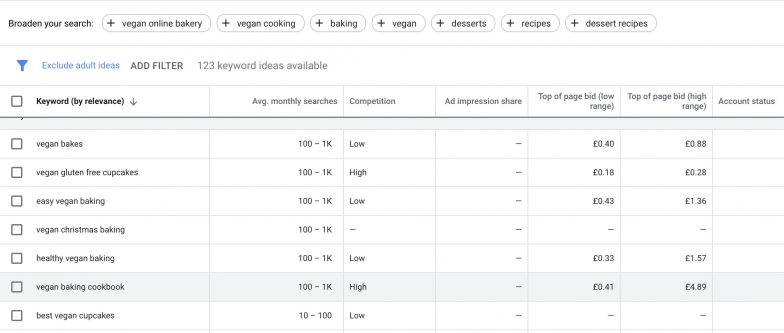
It’s then a case of “Googling” the most relevant keywords and seeing which blogs, video channels, podcasts, companies, and other course creators rank high…

Once you have a list of your core competitors you can research their social media campaigns and performance using tools like Sprout Social, SEMRush, MozBar and Buzzsumo.
For each main competitor make a note of:
- The social media platforms they’re on…
- How large their following is (and how fast it’s growing)…
- Who their top followers are…
- How often they post…
- What their engagement rate is like…
- What hashtags they use the most…
- How many hashtags they use…
Your goal here is to learn more about what your competitors are doing. As you do, you’ll come up with new ideas of your own, spot patterns, and have all you need to create your own social media marketing strategy.
STEP 2. Create Your Strategy
The most important thing to remember when creating your social media marketing strategy is that it can (and will) develop over time. It doesn’t have to be perfect from day one. It’s better to start, track, and measure something rather than spend months coming up with a sophisticated plan.
In short…get started!!
The key elements of your strategy to consider are:
- The social media platforms you will use
- The type of content you will create
- Your social media marketing goals
- Who your customer profile is!!
That last one is an important one. Your entire social media strategy needs to speak to someone. If you don’t have a clear Customer Avatar, now’s the time to create one. The social media landscape is a large one, as we’ve already discussed. You could reach millions of people.
But the most important part of all is to create engagement. And this only happens if you create specific content for specific people. So, get clear on who these people are (for a complete guide on how to create your customer profile, click here. )
Once you know who you’re targeting, ask yourself the following questions.
- Which platforms are your main avatar already on?
- What content do they engage with the most (video, podcasts, articles…)?
- Which hashtags do they use (if any)?
- How do they consume content (laptop, phone, at home, in the office…)?
To begin with, it’s better to focus your social media strategy around two to three platforms. In time, you can grow your strategy so it covers more platforms and reaches more people. Yet in the beginning, it’s vital you build momentum.
Finally, you need to set some clear and attainable goals to drive your strategy forward. Without setting goals like these, you’ll never know how far you’ve come. It’s hard to know what works, what doesn’t, and where your energy should go.
For a comprehensive guide on how to set clear social media marketing goals, check out this resource from Hootsuite.
Each social media marketing strategy differs from the next. But as long as it’s aimed at someone, focuses on a few specific platforms, and centers around clear goals, your strategy will beat most of your competition.
STEP 3. Build ONE Core Message
This is the part of the process that excites most people. It involves creating the content, writing the posts, recording the videos, and jumping on the mic.
Yet creating content for the sake of it no longer works in this content-driven world. You need to have something that people want to consume, that stands out from the rest.
And while doing all this you need to balance it with your own time and energy.
After all, you have more to do than to create social media content all day…right?
Of course you do, which is why this approach to content creation often makes the most sense.
Popularized by Gary Vaynerchuk, it involves creating one piece of core content and then repurposing this into lots of other pieces. For example, let’s say a YouTube Channel forms part of your social media marketing strategy.
Each week, you publish one high-quality, in-depth video.
You can then take this one piece of content and repurpose it into:
- 2 to 3 short video trailers (perfect for Facebook and Instagram)
- Memes or visual quotes (ideal for Instagram, Pinterest, and Twitter)
- An audio-only podcast episode (so you can launch a podcast as well as a video channel)
- A high-quality blog post that focuses on one core takeaway from the video
- 2 to 3 short written posts that discuss key points from the video (perfect for Facebook and LinkedIn)
With this approach, you have an entire week’s worth of social media content even though you only create one video.
It’s the simplest way to create consistent, high-quality content for your social media campaigns. This way you can plan your content weeks or even months in advance. You can record an entire month’s worth of videos in one morning.
Providing your audience with relevant and high-quality content that feels fresh and new fuels your social media campaigns now and in the future. Best of all, this approach also helps you achieve the next step in this process, which may be the most important one of all.
STEP 4. Craft a Consistent Content Creation and Publishing Schedule
There’s no right or wrong approach to how much content you publish each day/week. Different platforms cater to different frequencies. For instance, you may need to “tweet” more on Twitter because each message is short.
But if you publish ten or more long-form written posts on Facebook, it’s sure to overwhelm your audience. Instead of thinking about how much content you should publish each day, what’s more important is to think about how consistent you are.
When it comes to successful social media campaigns, consistency is crucial.
In step 3, you create a constant stream of content you can use. In this step you need to focus on where and when you will publish this content. Again, there’s no exact science to this. A lot of it comes down to you and your audience. You may have to experiment with different schedules to see what works best.
Yet throughout it all, consistency remains key.
You also need to find the right balance between promotional material and value-driven content. Although you want to provide your audience with value, you also have certain goals to achieve. You want to sell more courses, grow your email list, and sell products and/or services.
Building trust through social media helps you leverage this.
So you need to promote what you offer from time to time.
Yet not so much that you “sell” more than you serve.
It can be a tricky balance to get right, which is why using a social media scheduling tool like CoSchedule, Buffer, or Hootsuite helps. Not only do they allow you to schedule your posts ahead of time, but also visually show you what type of content you’re publishing (and when).
Without using a tool like this you may place too many promotional messages too close together, or publish too many posts on one platform and not enough on another.
The bottom line is: make sure you create a publishing schedule, stick to it, and use relevant tools to make your life easier.
STEP 5. Track Your Results
Now is the time to revisit the goals you set in step two of this process.
If you want to achieve them, you need to measure your results over time.
To do this, you must track certain data each day, week, or month.
What you track and how depends on the goals you set. They may focus on follower growth, comments, shares, or other forms of engagement. You may also want to track email subscribers, visits to your sales page, or website traffic as a whole.
So for each goal you set, make sure you create 2-3 KPIs (key performance indicators) that you can track on a regular basis. Keep it simple in the beginning. Tracking too much can become worse than tracking nothing at all.
Also be sure to build a spreadsheet that houses all your core metrics.
And then schedule when you will track this data!
Once more, consistency is key. Don’t track all this once. Don’t do it only when you have the time to. Make it an important part of your process. These results not only show you how far you’ve come, but help you decide where to go next.
STEP 6. Analyze Your Results
This final step is important because there’s no point tracking your results if you don’t take the time to analyze them. Again, how you analyze your results (and how often) depends on the goals you set.
You may have to set aside time each month, or possibly once per quarter.
What matters is that you analyze the results you track and make informed decisions on the back of them. There’s no such thing as a perfect social media campaign. Whatever you create you can improve upon. Yet you only can if you take the time to analyze your results and measure what’s working.
- Which platform(s) isn’t performing as well as it should?
- Should you dive deeper into this platform or cut it from your social media strategy?
- What type of content drives the most engagement?
- Which results surprise you the most (either in a positive or negative way)?
Most people do not track their progress. This leaves them at a disadvantage, but gives those who do a huge opportunity over everyone else.
Be one of those who completes the process in full. If you do, you’ll create successful social media campaigns that grow over time.
We’ll share some of these successful social media marketing examples with you now.
The 9 Best Social Media Marketing Examples
The following are the best social media marketing examples we have found in recent years.
As you read through this list, study each example.
We share these to inspire you to create your own social media campaigns.
Not to copy or try to replicate. Rather, to show you how the best do it so you can achieve the same.
1. Gillette
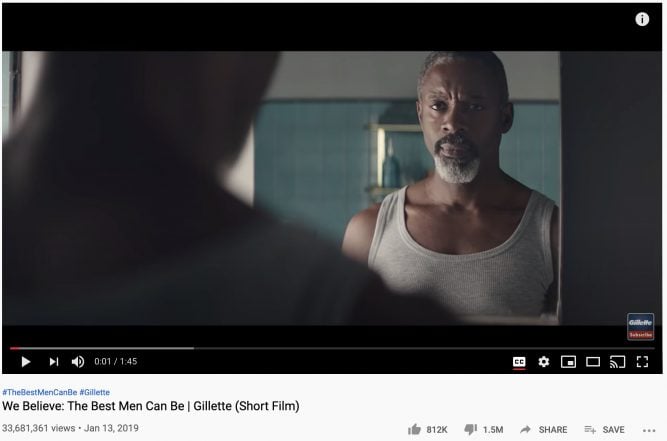
In 2019, Gillette launched its somewhat controversial “best a man can be” campaign.
Centered around a powerful video, it spread across multiple social media platforms in the form of videos, clips, and memes. It’s a divided campaign that has turned certain customers away from the brand. Yet in doing so it spoke to others on a deep level, and helped build rapport with a new generation.
What You Can Learn From This Social Media Marketing Example
This is one of the most polarizing social media marketing examples on this list. It shows that you don’t always have to appeal to everyone in order to build success. Released as the world began to open its eyes to the #Metoo movement, Gillette realized it has played a part in the problem for many years.
They took a stand, even though it meant turning many loyal customers away.
Social media is a great platform for achieving this. It allows you to share a message.
To stand for something and bring those you’re speaking to closer.
Even it means creating conflict with the masses.
2. Starbucks
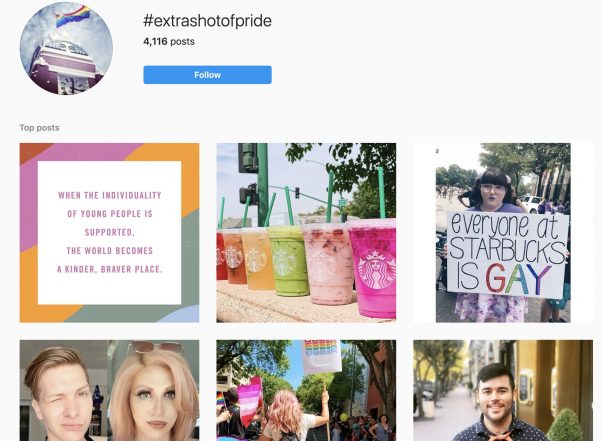
In June 2019, Starbucks created the #extrashotofpride social media campaign to celebrate Pride month and support the LGBTQ community.
As part of this campaign, they posted colorful pictures of people from the community, asking their followers to check out their Instagram Stories/Highlights and to share their own. Focused prominently on Instagram, this campaign centered almost exclusively around images and videos.
What You Can Learn From This Social Media Marketing Example
With this campaign, Starbucks jumped on an existing bandwagon that had already built momentum. In general, the LGBTQ community is gaining a greater voice in the public domain; and Pride month is an event celebrated across the world.
Starbucks leveraged this, not by selling or promoting their products, but by being part of the conversation. When you join a conversation that matters like this one, your brand quickly becomes a part of it.
3. Dove

As a brand, Dove has always focused on social causes in their social media campaigns. Often these center around women’s equality, empowerment, and diversity, in a bid to break the standard stereotype.
This has never been more apparent then in their #ShowUs campaign.
Through it, Dove engaged with their audience on a deep level, collating 10,000+ user-generated images that they and other businesses can use as part of their marketing campaigns.
What You Can Learn From This Social Media Marketing Example
Through their #ShowUs campaign, Dove proves they understand who their customer profile is.
They spoke directly to them.
They engaged them on a deep level.
10,000+ images from their audience says it all. All Dove did was provide a platform to share these. They created a message, and a movement rose from it. Yet it all comes down to knowing who your audience is, what pain they feel, and how you can play a role in solving it.
4. Lush
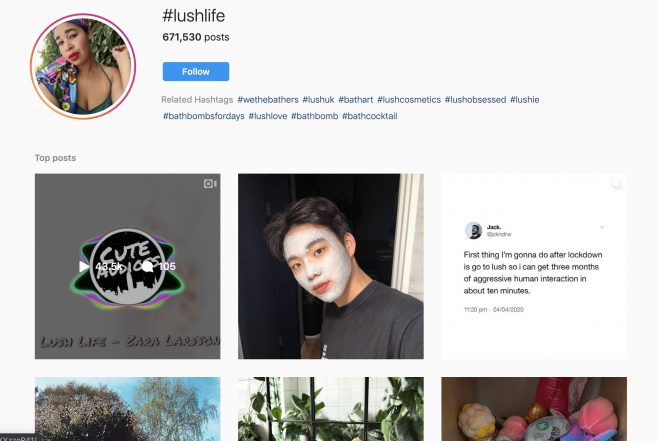
As part of an ongoing social media campaign, the cosmetics company, Lush, engages with its audience and encourages them to share their #lushlife.
Through Instagram, they’re able to engage with their audience on a one-to-one level while creating a community of like-minded people at the same time.
What You Can Learn From This Social Media Marketing Example
The ingenious part of this social media campaign is that Lush plays a very small role in it. It takes place on Instagram. It’s Lush’s audience that generates the content and it’s Instagram that hosts it.
Lush merely uses this to engage with them and measure the type of engagement that follows. This is the power of social media in the twenty-first century, if you approach it in the right way.
5. Apple
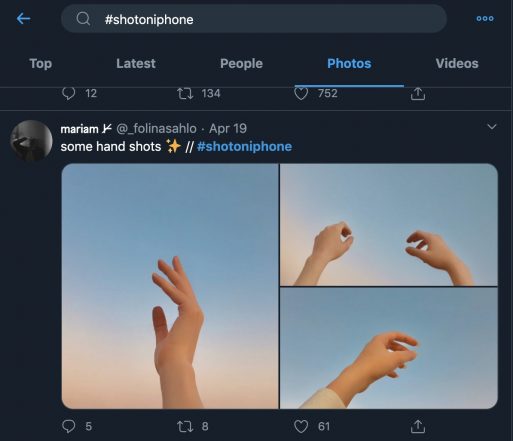
Another user-generated example, Apple created the #ShotOniPhone campaign to great effect in 2019.
Spanning across Instagram, Twitter, and Facebook, the #ShotOniPhone campaign empowered Apple’s already loyal audience to become part of their marketing efforts. They gave their users a large platform to share their art and work, while demonstrating the power of their product at the same time.
What You Can Learn From This Social Media Marketing Example
Not only did Apple engage with their audience through this campaign, but they subtly placed their product at the center of it all. At no point did they “sell” it or promote it. Yet by encouraging talented photographers to share their art, they showed the world just how powerful Apple’s latest phone (and camera) is.
Apple’s role in this was very small. They created a call to action and allowed their customers to do the rest. Yet this is what social media is all about. You, as the brand, may start something.
But for it to truly work, it needs to grow way beyond you…
6. Marie Forleo

At the start of each year, the online world gets flooded with ads, messages, and campaigns promoting Marie Forleo’s B-School program. Her annual course is one of the year’s most anticipated, yet Marie herself doesn’t do much of the promoting.
Instead, partners from across the globe do the hard work for her, fueling the fire with case studies, interviews, and testimonials from old and new students alike.
What You Can Learn From This Social Media Marketing Example
The best form of marketing is to build a loyal audience that does the work for you. Be this through existing customers and advocates or joint venture partners and collaborators, the most powerful way to reach more people is to utilize the influence of others.
The same applies to social media campaigns.
What you do can only go so far. When you involve other people, businesses, and influencers, your ability to create mass awareness increases.
7. Masterclass
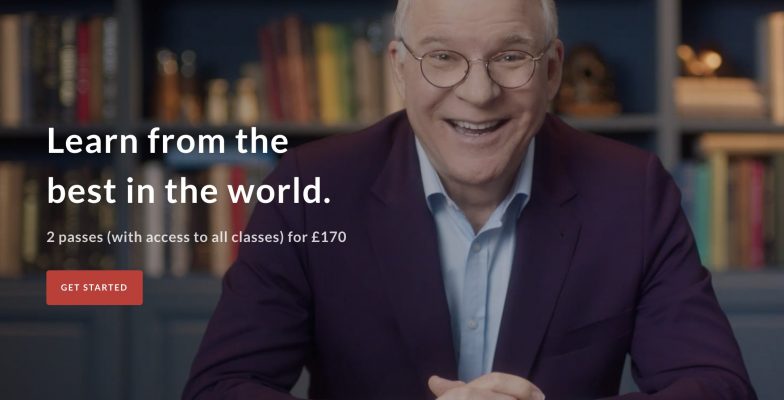
In 2014, Masterclass formed and provided a high-quality online education platform that brought some of the world’s most famous faces into your home. From Steve Martin to Steph Curry, Masterclass offers 80+ lessons from true masters of their craft.
A huge part of their success has come through social media, sharing video snippets of the classes themselves on platforms like Facebook and Instagram.
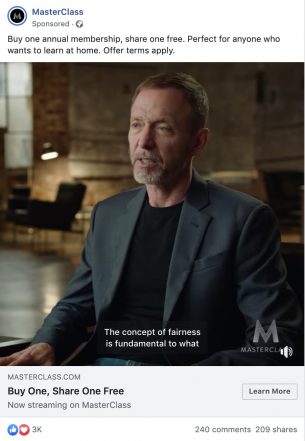
When a famous face like Helen Mirren, Natalie Portman, Malcolm Gladwell, or James Paterson appears on your newsfeed, it’s sure to stop you from scrolling any further.
What You Can Learn From This Social Media Marketing Example
You may not have access to Martin Scorsese or Bob Iger, but you likely can collaborate with other influencers in your industry. Having them become a part of your social media campaigns not only creates credibility, but helps you get noticed in this noisy world we live in.
Oftentimes your most important job is to stop your audience from scrolling any further…
8. Foundr
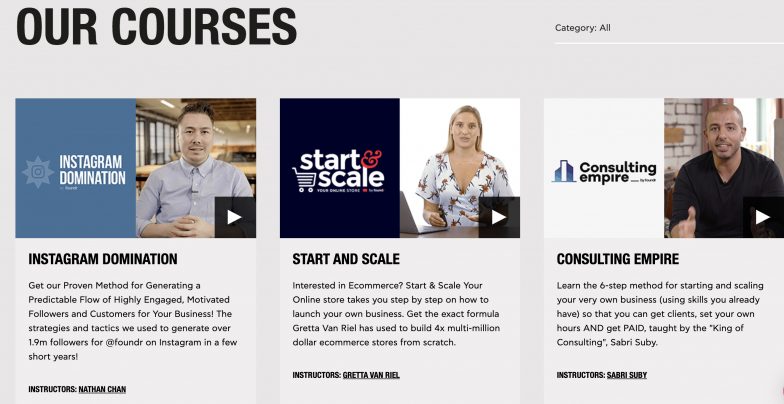
As well as publishing a popular magazine, Foundr produces some of the best online courses around. Featuring expert instructors like Raymond John, Ari Meisel, and Alexa Von Tobel, Foundr has an array of courses on offer.
One of the ways they promote these is by creating unique, engaging, and stand-out Instagram stories.
Featuring explainer videos, student testimonials and stories from the instructors themselves, these videos are shot and split specifically with Instagram Stories in mind.
It’s engaging and unique; perfect for today’s Instagram-driven society.
What You Can Learn From This Social Media Marketing Example
Video is a great way to create engagement with your social media campaigns. Yet it’s no longer enough to record a standard video that you upload across all platforms. You need to tailor these videos for their different environments: Facebook, YouTube, Instagram, Instagram Stories, LinkedIn…
New features like Instagram and Facebook Stories bring new opportunities for creators like you. Foundr shows us what’s possible by taking an existing video and editing specifically with this feature in mind.
9. Copyhackers
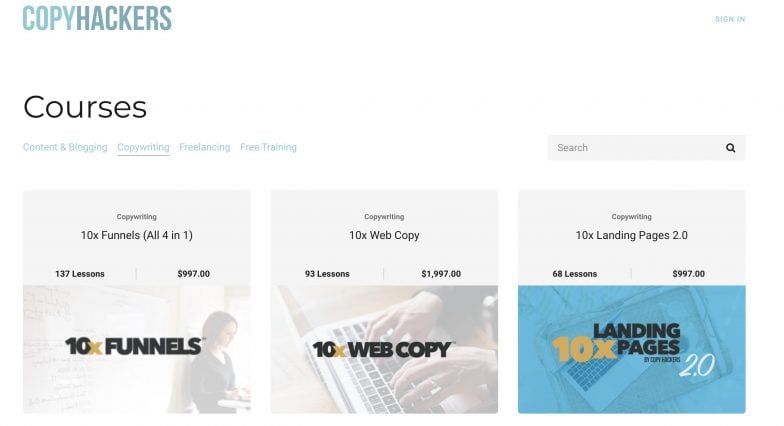
Copyhackers is one of the web’s go-to resources for all things copywriting: including funnel creation, web copy, email marketing, and guest blogging.
Over the years they’ve produced many successful online courses, collaborating with experts in their field. When they do, they take attention away from the Copyblogger brand and instead place it on the expert’s story.
Take their course on Guest Blogging, led by Aaron Orendorff.
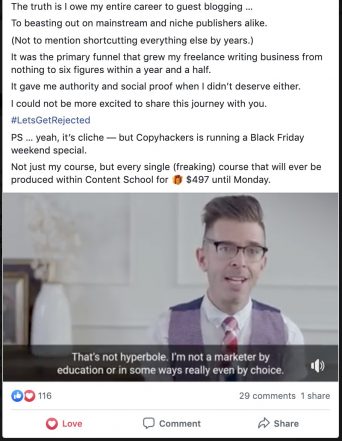
Although this video promotes the course, its premise surrounds Aaron and his story. It brings a storytelling angle into their social media campaign, blending a promotional post with one designed to build trust and rapport.
What You Can Learn From This Social Media Marketing Example
Social media is one of the best places to bring storytelling into your marketing. As this social media marketing example from Copyblogger shows, you can still utilize storytelling when selling and launching a course.
Bring your story into it. Bring your collaborators into it.
So often it’s a story that plays a key role in any successful social media campaign.
Now Go Create Your Own Social Media Campaigns!
Having read this guide, you now know what the best social media marketing examples look like. Your job isn’t to replicate these, but rather take inspiration from them so you can create your own.
Social media can be an incredible tool for any business.
Yet most don’t approach it in the right way, wasting both time and money.
You now know the process to follow to create effective social media campaigns.
The question is…will you follow it?
If you choose to, you need to place engagement at the heart of everything you do. Engagement is crucial for building successful social media campaigns, no matter which industry you’re in.
To take your engagement to the next level, you may like to read Engagement From Scratch. You can grab your Free copy by filling out the form below.
Create Your Loyal Audience (from Scratch!)
Get the guidance and insights from 30 of the world’s most successful audience- and community-builders to turn your internet business into a true audience business.
